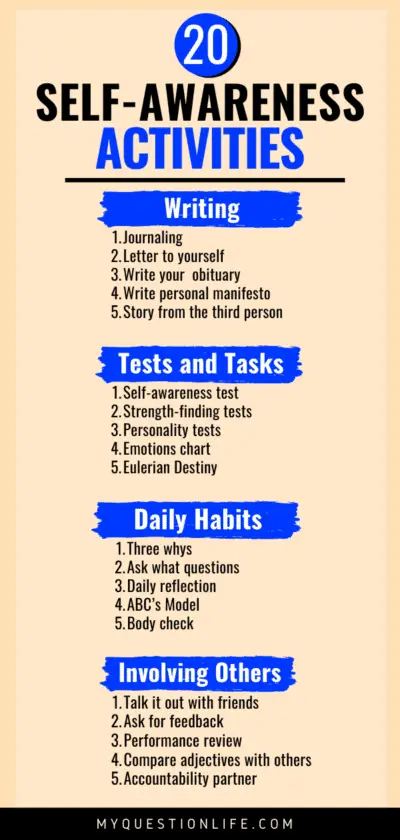20 Self-Awareness Activities You Need for Emotional Intelligence
I spent much of my young adult life thinking that I was self-aware. As a naturally curious person, I always tried to explore the deeper meaning behind my actions. I filled my mind with questions, journal prompts, and other things I considered helpful self-awareness activities.
At the root of all my searches lay the question: Why am I the way I am? I believed asking this question meant that I was self-aware.
It took me until years later to realize how terribly wrong I was.
Self-awareness is incredibly difficult to achieve, yet it’s incredibly beneficial for your life. In fact, I would argue self-awareness is the necessary foundation for living a happy, purposeful life. Being self-aware will enhance your relationships and your self-growth.
Fortunately, self-awareness is something you can always improve. To help you do so, I’ve created a list of 20 Self-Awareness Activities below, each with a brief description and helpful resources. I’ve also divided the activities on self-awareness into four categories to help you choose.
If you want, you can skip down to the list of activities right away. But first, I’d recommend taking a look at some examples of self-awareness and why you’re probably lacking it.
What is self-awareness and why is it important?
Self-awareness is one’s ability to identify and understand their feelings, thoughts, and behaviors. As a result, you can monitor yourself better and create a more purposeful life.
At the heart of self-awareness is our emotional intelligence. Our emotions almost always get in our way (despite self-awareness activities meant to help us). Coupled with our brain biases, we’re already starting from behind.
For example, I know what’s best for me, but I don’t always do it. Why not? Rationally, it would make sense. But emotionally, I have a whole herd of obstacles and human tendencies stopping me. When I became more self-aware, I began to notice the actual reasons behind my actions (and lack thereof).
How self-aware are you?
The majority of people think they’re self-aware when they’re not (myself included). Honestly, it’s better to just start with the mindset that you lack self-awareness. Still don’t believe me?
Take this self-awareness test to see where you might be falling short in the self-awareness category.
.
20 Self-Awareness Activities to Help You Improve Your Self-Awareness
These activities on self-awareness are divided into four categories. While every single one is helpful, it’s important to find ones that you would actually enjoy. That way, you’ll be more likely to complete them and improve your emotional intelligence.
You can find a list of links below to skip to a specific activity for self-awareness.
Writing Self-Awareness Activities
- Journaling
- Write a letter to yourself
- Write your own obituary
- Write your personal manifesto
- Tell your story from the third person
Test and Task Self-Awareness Activities
Daily Habit Self-Awareness Activities
Involve Others Self-Awareness Activities
- Talk it out with friends
- Ask for feedback
- Performance review
- Compare adjectives with others
- Accountability partner
.
.
Writing Self-Awareness Activities
1. Journaling
Journaling is probably one of the most common recommendations for self-awareness activities. Writing about our lives helps us realize our priorities, emotions, and triggers. After all, it’s in reflection that we achieve the most learning.
You can explore questions for self-discovery to build self-awareness. You will be better able to identify and manage your emotions by writing them on paper. Not only will journaling help you improve your emotional intelligence. It’s also been proven to decrease stress levels, boost your mood, and strengthen your memory.
Keep in mind, there’s a right way and a wrong way to journal effectively. You need to make sure you avoid only using a journal to vent or fixate on problems. It’s also critical that you journal in moderation. Every once in a while, step back from your journal and give your questioning mind a rest. Think about it with the analogy of going for a swim. Swimming is a healthy and refreshing activity, but you need to get out of the water and give yourself a break from time to time.
Additional resources:
- 22 Questions for Self-Discovery – questions to take you through the 7 levels of personal insight
- 10 Bizarre Questions to Understand Yourself – unconventional questions to present you with new ways of thinking and thus, new answers
.
2. Write a letter to yourself
For some people, it’s hard to write without a specific audience in mind. Unfortunately, the majority of us don’t have many people who can serve as our “Dear _.” (Not to mention the vulnerability we’d need to do so).
A simple solution is to write a letter to yourself. You can choose which version of yourself you want to write it to. Do you want to give advice to your past self? Yourself as a child? Or perhaps it’s easier to write a letter to your future self. Who do you hope to become?
This is one of the activities on self-awareness that you don’t need to do very often. When you do undertake it, however, you might be surprised by the insight you gain. It allows you to step outside of your own mind and gain a new perspective on who you are as a person.
Additional resources:
- How (and why) to Write a Letter to Your Future Self – an excellent post that offers tons of questions and ideas for what to write about
- FutureMe.org – a fun site that allows you to write a letter, which it will email to you at a specified time in the future
.
3. Write your own obituary
Don’t be fooled by the name of this self-awareness activity. While it might sound morbid, it can actually be incredibly insightful for you. Self-awareness is divided into two categories: internal and external self-awareness. External self-awareness revolves around how other people see you.
By writing your own obituary, you can consider how you want other people to see you. What do you want to be remembered for? What do you want people to label you as? What do you want your legacy to be? Feel free to be light-hearted with what you write. The main goal is to consider what kind of person you want to be known for.
Additional resources:
- Write Your Own Obituary from the Liberationist– an in-depth explanation of how to tackle this exercise, including questions and the steps
.
4. Write your personal manifesto
“Personal manifesto” might sound theatrical and dramatic, but we all have one inside of us. The question is if we take the time to intentionally craft it.
Think of the mission statements or mantras you know. Perhaps they’re for an organization, team, or person. They provide “words to live by” for whomever they lead. Consider what you want your “words to live by” to be. What’s most important to you? What core values do you want to drive your life?
This activity for self-awareness will help you find more clarity in the direction you want your life to go in. Knowing your core values can have transformative effects on your life, including smoother decision-making, stronger relationships, and more precise goals. Keep in mind that your personal manifesto will probably change as you encounter new experiences in life. That’s okay. The trick is to keep being self-aware of these changes.
Additional resources:
- How to Write Your Personal Manifesto – 5 simple steps on how to write your personal manifesto from WellandGood.com
.
5. Tell your story from the third person
This activity to help you become more self-aware requires a bit more impartiality in terms of the narrator. Rather than thinking in the “I” perspective, you need to step outside yourself and tell your story from the third person. The simple act of saying “Kara did this” instead of “I did this” will help you break past some of the things that generally limit our self-awareness.
Consider the significant events and experiences in your life. What are the highlights of your life? Major conflicts? When did you have to make a big decision? How have you changed over the years? By answering these questions, you’ll tap into insight about yourself that you wouldn’t have realized otherwise.
While this activity falls under the writing category, you can just as easily do it with an audio or video recording. If you like to doodle, you can draw a cartoon of your life.
Additional resources:
- Tricking Your Ego: Writing in the Third Person Frees You to Explore Your Story – an easy-to-understand explanation of why writing in the third person allows you express your life story easier
.How to Writ
Test and Task Self-Awareness Activities
6. Self-Awareness Test
It might seem funny to improve your self-awareness by taking a self-awareness test. However, it’s a fantastic way to learn more about yourself and specifically where you need to grow. Since we’re biased to think better of ourselves than we are, we need outside sources – like a self-awareness test – to show us the truth.
Taking a self-awareness index can give you this truth you’re looking for. While we might think of entrepreneur as solely business owners, having an entrepreneurial mindset is something that will benefit all of us. Whether you are pursuing a business or want to attack a new project in your life, it’s critical you understand your strengths and self-knowledge. As an example, only 28% of small business owners have accurate self-knowledge. This leads to wrong decisions based on their wrong self-image, ultimately resulting in failure.
By taking online tests and assessing your self-awareness, you can improve your self-knowledge and make decisions that will lead you to more success.
Additional resources:
- Entrepreneur Scan – a comprehensive site filled with assessment tests, tools, and professional training resources for you to understand your strengths and where you can grow. You can start with a free E-Scan to see what they can offer, and explore a 360-degree Feedback tool that is based on an advanced algorithm to solve the Catch-22 of assessing your self-awareness.
.
7. Strength-finding Test
Finding your strengths will not only help you improve your self-awareness, but it will help you be more successful. Many of us generally know what we’re good at. But do we know what those strengths look like in action, and how to design our lives around them?
Fortunately, there are some helpful, free strength tests online. Consider the list below. You might be surprised by the results that you find.
Additional resources:
- 4 Ways to Discover Your Strengths – a guide for 4 simple steps you can undertake to discover your strengths
- VIA Survey of Character Strengths – a free 25-minute test that will tell you how you rank with the 24 character strengths, determined by leading strengths researches in the field
- High 5 Test – a free 5-minute test that will tell you your top 5 strengths
- Wingfinder – a free 10-minute test that will give you your top strengths in four main areas: creativity, drive, thinking, and connections
.
8. Personality test
There’s a reason there are so many personality tests online. That’s because understanding your personality is critical in living a self-aware life.
Knowing your personality can help you understand the people and experiences that best suit your needs. You can also more proactively manage your emotions and reactions. Then, you can put this knowledge into action by seeking out situations that will best suit your personality.
When taking these personality tests, keep in mind that there’s no one “best” personality. The beauty of personalities is that there’s a wide range. The goal, then, is not to achieve a specific one, but instead to be more self-aware of what category you fall into.
Additional resources:
- 16 Personalities Questionnaire – This one takes about 25-30 minutes to complete, but it’s entirely free and gives you an extremely in-depth description of what your personality type means in terms of your strengths, weaknesses, career, friendships, and romantic relationships.
- Personality Perfect – This test is only 30-questions long and will give you a broad overview of how you connect and are seen by others.
- For more, check out: 14 Free Personality Tests You Can Take Online Today
.
9. Emotions Chart
This activity on self-awareness might seem basic at first, but it can give you surprisingly insightful information about yourself. All you need to do is create a chart with two columns. On one side, you list as many emotions as you can. Then, you write out what causes these emotions in your life.
When we experience emotions, we often don’t take the time to name the emotion. The simple act of listing the feelings you have is a great way to develop your emotional language.
Furthermore, we often get caught up in our feelings in the moment and fail to recognize emotional patterns. If you are more self-aware, you can begin to identify the predominant emotions in your life and what triggers them. Then, you can find ways to promote more positive emotions and mitigate the negative ones. Emotional intelligence is the key to designing a happy, purposeful life.
Additional resources:
- Healthline’s List of Emotions – a comprehensive list of 54 emotions, along with how to talk about each emotion and tips for handling this emotion in your life
.
10. Eulerian Destiny
You might not have heard of the Eulerian Destiny before. (You also might be thinking “destiny” sounds a bit mystical). Don’t be turned off by the name. This self-awareness activity is simple, but it can help show you a lot of truth about your life through a broader perspective.
The Eulerian Destiny is intended to help you find what you are best suited for. But instead of a bunch of complicated career tests and profiles, it gets you thinking with four questions:
- What did you grow up around? (Think of your parents, childhood values, environment)
- What did you do in the last 5-10 years? (Think of constants in your life, whether they be a job, hobby, location, as well as what you’ve spent thousands of hours doing)
- What can you talk about for hours? (Think of the fun conversations you have)
- What do others say about you? (Think of feedback you’ve gotten, both formal and informal)
With these four questions, you can analyze where your answers overlap. Then, you can consider what that might look like in your life.
Additional resources:
- How to Discover Your Eulerian Destiny – an easy breakdown of the four questions for your Eulerian Destiny
- Eulerian Destiny: How To Do “You” Better than Anyone Else – a comprehensive explanation of the Eulerian Destiny, along with questions and ideas for how to take on this activity
.
Daily Habit Self-Awareness Activities
11. Three whys
Sometimes activities on self-awareness can seem time-consuming and daunting – but they don’t have to be. One habit you can incorporate into your daily life is asking the “three whys.” Whenever you contemplate a decision or experience an emotion, ask yourself, “Why?” three times.
The repetition of questions might seem frustrating at first. If you stick with it, however, you’ll be surprised by the truth you can find. Too often, we live on the surface level of self-awareness.
For example, let’s say I decide to go for a run after work. Why do I want to go for a run? Because I feel stressed. Yes, but why do I feel stressed? Because I’m doing a lot at work. Why am I doing a lot at work? Because the deadlines are fast-approaching, and I feel like my coworkers aren’t supporting me in my efforts.
Bingo. Now, I can get to the more profound truth of the matter and start making plans to help put myself in a better position. Don’t overlook the benefits that the “three whys” can give you.
Additional resources:
- The Theory of the Three Whys – a good article on how powerful the Three Whys can be when trying to make a decision
.
12. Ask what questions
It might seem contradictory to encourage “what” questions right after telling you to ask the “three whys.” However, there’s a time and place for both, and it’s essential to understand the distinction.
Especially when we’re feeling negative, we have a tendency to fall into a blaming mindset. Our emotions get the best of us, and we slip from a problem-solution mindset to a “woe is me” mindset. We ask questions like, “Why is this happening to me?” These “why” questions, while fun in late-night philosophical conversations at the bar, don’t set you up for self-awareness in your personal life.
Asking “what” questions can help you get closer to the truths about your own life that you’re looking for. Instead of, Why am I unhappy? You can ask, What is causing my unhappiness? Suddenly, you’ve given yourself more opportunity to find definitive answers. As you go about your day, try to be aware of the language you use and the storytelling perspective you’re using.
Additional resources:
- Increase Your Self-Awareness With One Simple Fix – a 2:30 minute Youtube video in which leading Self-Awareness expert and author Tasha Eurich explains the power of “what” questions
.
13. Daily reflection
Sometimes we think of reflection in terms of huge, elaborate activities. In reality, it’s easy to implement the tiny habit of reflection into your daily routine.
The best way to start a new habit is to attach it to an existing one. Consider your daily routine and where you can take a moment to reflect. Perhaps it’s while you’re driving home from work, or eating dinner with your partner, or brushing your teeth before bed. Use this consistency to check in with your emotions and reflect on the day. What went well? What didn’t go well? How did your actions contribute to it? What emotions did you experience today?
Establishing a routine for a daily check-in will help you notice patterns that you wouldn’t otherwise. It’ll also give you the practice of identifying and naming your emotions each day.
Additional resources:
- How to Start (and Stick) With a Daily Reflection Habit – a list of 7 easy action steps you can take to implement a daily reflection into your routine
.
14. ABC’s Model
We all probably have some recollection of learning the alphabet. As we got older, the ABC’s just came naturally to us. You can have a similar experience with this activity on self-awareness.
Life is a series of causes and effects. Unfortunately, we don’t always realize – in the moment or afterward – what precisely those causes and effects are. To better understand our behaviors and the motivations behind them, you can conduct a quick “ABC” check on the situation that includes:
- A: Antecedent and attitude: what was the situation or event, and how do we feel about it?
- B: Behavior: what behavior did we take as a result of the situation and our attitude?
- C: Consequence: what was the result of our behavior?
For example, let’s say my fiancé forgets to buy shampoo at the store. I get angry and begin to yell, which further escalates the situation. If I consider my ABC’s, I can see:
- A: I felt like I couldn’t depend on him and got angry.
- B: I chose to express this by yelling
- C: we got into a big fight that didn’t help anybody.
Once I identify these three steps, I can reflect and consider which part – A or B – I can improve on for next time if I want a different consequence.
.
15. Body check
The mind-body connection goes much deeper than many of us acknowledge. Still, we often neglect our bodies when thinking about self-awareness activities. Our emotions and thoughts are rooted in our physical bodies and vice versa. This stems all the way back from the prehistoric days when we needed the two to be aligned to survive.
An easy habit to improve your self-awareness is to perform a “body check” periodically. (And no, I’m not talking about a physical examination like you get in your doctor’s office). All you need to do is take a moment to pause and assess how your body is feeling. Consider:
- Any tightness or frustration in your chest cavity
- If you’re doing any behaviors that indicate you’re anxious or stressed (for example, I pick my nails obsessively when I’m nervous)
- Whether or not you feel relaxed or unrest
The sooner you can listen to your body, the sooner you’ll be able to identify what you need to be happy.
Additional resources:
- Body Check-In: What It Is, and How to Do It – a great article on the purpose of a body check, as well as a breakdown of 7 specific steps you can take to check in with your body
.
Involving Others Self-Awareness Activities
16. Talk it out with friends
Does this self-awareness activity seem straightforward? That’s because it is. We usually get the most lost when we’re stuck in our own heads. Our emotions and fears get the best of us, and it can be hard to find our ways out of our unaware mindset.
By talking out things with our friends, we can get out of our heads and benefit from another person’s insight. Think of a time when you’ve been struggling to solve a problem for a while. Has anyone ever walked up to you and immediately seen the solution? It’s not your fault; it’s just that a bunch of biases and emotions were blinding you to the truth.
Regardless of the issue at hand (it could be a problem, fear, goal, dream, etc.), talking it out with your friends can drastically speed up your journey to self-awareness.
Additional resources:
- Why Talking About Our Problems Helps So Much (and How to Do It) – a NY Times article full of research, examples, and guidelines for why conversations can help you
.
17. Ask for feedback
Asking for feedback requires us to be vulnerable. Still, it’s one of the self-awareness activities that can give us incredible insight into ourselves. By asking others, we can gain more self-awareness about our behavior and impact on others.
While many of us associate feedback with formalized evaluation, it doesn’t need to be. Asking friends or coworkers simple questions can still yield insightful results for us. You can ask:
- How am I doing as (insert role or activity here)?
- What am I doing well?
- How can I do better?
When seeking feedback, you must do two things. First, you need to ask people that you trust will be honest. Second, you should give yourself time to receive and reflect on the feedback. It’s our natural instinct to get defensive and reject any negative feedback. However, understanding where we can improve can do wonders.
Additional resources:
- 3 Reasons You Need External Self-Awareness – a look at what external self-awareness is and how you can receive feedback from others in various ways
- The 4R Feedback Model – a quick look at how you can receive feedback in an effective way
.
18. Performance review
If you want more formal feedback, one of the activities on self-awareness is conducting a performance review. You might imagine office cubicles and cheap suits when you hear the words “performance review” (or at least, I do). However, performance reviews can be on anything that you do – big or small.
There are many surveys and templates you can use to improve your self-awareness. You can also make your own based on what you’re looking for. The key is to compile a circle of reviewers who have seen you in action. It’s also helpful to try to enlist people of all levels in terms of hierarchy.
Everyone’s performance review will look different depending on their job. As a teacher, I am reviewed by my students and bosses. A salesman might ask clients for a review. The important thing is to not limit yourself by your idea for what a performance review should look like.
Additional resources:
- 12 Performance Review Examples and Templates – an explanation of what a performance review is and examples with downloadable templates
- 4 Examples of Performance Reviews that Inspire Greatness – a look at what the goal of performance reviews should be, as well as 15 tips for effective performance reviews
.
19. Compare adjectives with others
This self-awareness activity requires you to seek feedback in a simple, fun way. Think of a list of adjectives that you think describe you best. As much as you can, try not to make yourself sound good. After all, this isn’t a list of adjectives for a job interview. Instead, they’re words that resonate with your personality and beliefs.
Once you have your list, ask a handful of others what adjectives they would use to describe you. It’s helpful if the people you ask are both close to you and willing to be honest. Compile a list of all the adjectives people used to describe you. Initially, you can compare the lists from others and see if any trends emerge.
After that, you should compare these lists to your own. Do you see yourself the way others see you? Not only can this self-awareness activity show you how others view you. It can also teach you how self-aware you are compared to others’ perceptions of you.
Additional resources:
- List of Adjectives for People – an alphabetical list of adjectives that can be used to describe people
.
20. Accountability team
Learning to be self-aware is not easy, nor is it always fun. Vulnerability is necessary for improving your self-awareness and overcoming some of these obstacles. However, it’s only natural that you might feel like giving up or taking the easy way out. Remember, humans are wired to seek pleasure and avoid pain.
For this reason, enlisting an accountability team can help give you the extra urge to stick with your pursuit of self-awareness. These “teammates” might be a spouse, friend, or family member. You will tell them about your goals and check-in with them about what you’ve done. Furthermore, they can follow-up with you to make sure you’re staying on track and feeling motivated.
If you possess the self-awareness to know what motivation method works best for you, try to communicate this to your accountability team. Whether you need an upbeat cheerleader or a harsh coach, you can orchestrate this role to enhance your self-growth. You can also seek different things from different people.
Additional resources:
- 4 Benefits of an Accountability Partner – a short, fun post that looks at the different benefits an accountability partner can give you
.
Who Should Use These Self-Awareness Activities
Self-awareness, like vulnerability, is not exclusive to a particular type of person. We all need self-awareness to live happy, purposeful lives. We also need to be self-aware in all aspects of our lives, including at home, work, school, or in our free time.
These activities range in their nature and effort, but they still apply to a wide range of people. They can fill the needs for:
- Self-Awareness Activities for Adults
- Self-Awareness Activities for Students
- Self-Awareness Activities for Work
- Self-Awareness Activities for Employees
- Self-Awareness Activities for Kids
How Self-Aware Are You?
Want to see how self-aware you are? Take our 20-question, free self-awareness test to see where you might be lacking self-awareness in your life. Remember, 90% of us think we are self-aware… but only 10-15% of us actually are.
.
More Resources
Learn more about Self Improvement from SelfGrowth.com. SelfGrowth.com is the most complete guide to information about Self -Improvement, Personal Growth and Self Help on the Internet. It is designed to be an organized directory, with articles and references to thousands of other Web Sites on the World Wide Web.
.
Conclusion
Self-awareness is our ability to identify and manage our thoughts, feelings, and behaviors. While it sounds simple, multiple biases and deep-rooted tendencies get in our way of being self-aware.
Fortunately, with the right activities on self-awareness, you can improve. In the end, the benefits of being self-aware will be worth the effort you put in to achieve it.
Consider sharing this post with someone else to start creating your accountability team. If everyone is more self-aware, the world will be a kinder, more compassionate place.
.









These are really great ideas! You’re right, I’ve always considered myself pretty self-aware… but couldn’t really have given you a definition of what the even meant before reading this. ha.
And I have loved personality tests ever since I as a kid! I’ve taken the 16 Personalities one (I’m a campaigner… of course) and excited to try the other 30-question one you talked about. I’m also going to try writing my personal manifesto.
And I love the three why’s too! That’s kind of the way I approach everything naturally, like a little kid that keeps asking questions, but it’s a great way to interact with the world! Honestly tho, I don’t know if I’ve ever applied it to myself the way you describe here. Brilliant. Thanks for the inspiration!
Ketti
Thanks Ketti! Love that you’re a campaigner. I was a protagonist (hate the name, but the description definitely resonated with me). I’m a big fan of the why questions – thanks for commenting and giving me some encouragement!
Pingback: Be More Self-Aware: 5 Simple Habits ~ Madcashcentral Cash Content Curators